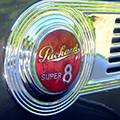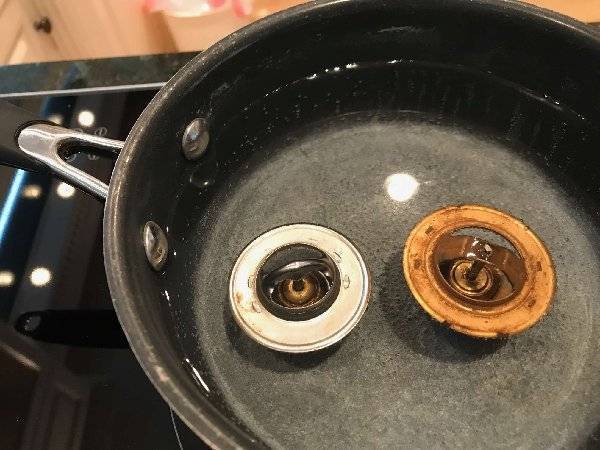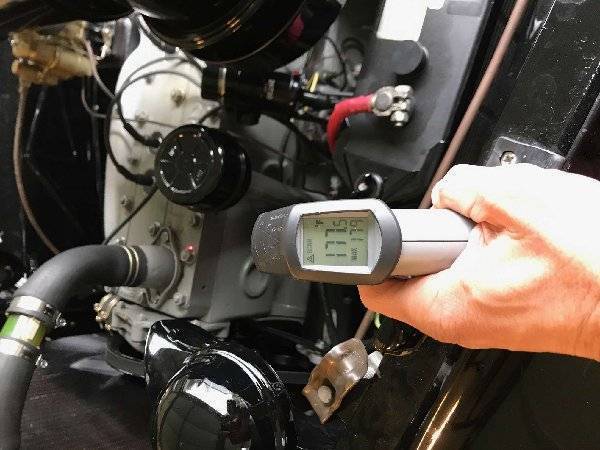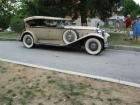|
Re: Change of radiator core affecting cooling performance in 1949, 23rd series
|
||||
|---|---|---|---|---|
|
Just can't stay away

|
I re-read Jim Gnitecki's excellent post from July of 2008 where he compares mechanical cooling to electrical cooling and shows the superiority of air flow when produced by the mechanical fan from the engine. It is a great explanation of why air flow produced from a mechanical fan is superior.
https://packardinfo.com/xoops/html/modules/newbb/viewtopic.php?post_id=9480
Posted on: 2017/9/9 7:30
|
|||
|
||||
|
Re: Change of radiator core affecting cooling performance in 1949, 23rd series
|
||||
|---|---|---|---|---|
|
Just can't stay away

|
In order to test the air flow at the radiator, I placed tissues in front of the radiator fins while the car was running at idle. What I found was that at the upper part of the radiator, the tissues clung nicely to the fins but at the lower portion of the radiator, the tissues did not stick at all to the fins. In fact, they would just drop off. Obviously, the air flow at the upper half of the radiator was good but not in the lower half. This test was done using the stock Packard mechanical pulley fan and no other fan or shroud.
After I noticed the deficient air flow in the lower half of the radiator, I placed my hand on the fins and determined that the upper half was cooling well but the lower half was very warm. This was a surprise to me since I would normally expect that the lower half of any radiator would be cooler than the upper half. As a result of my experiment, I moved the 6 volt pusher fan to the lower half of the radiator and installed it there. Then on the next day, when it was 82 degrees outside, I tested the new arrangement. I let the engine warm up to about 195 degrees at idle (tested with infrared meter at the neck of the thermostat housing). I then turned on the pusher fan now mounted to the lower half of the radiator and measured the results. After about 15 or 20 minutes, the test point at the thermostat housing cooled down to about 175 degrees. A 20 degree improvement! The rest of the engine also cooled accordingly. So it would appear that I have a temporary solution. My conclusion is that with the larger radiator, the fluid runs through it more slowly and that is the reason it warms up in the lower half of the radiator. Some experts say that it is good to have the fluid in the radiator longer. I could argue about this all day long with the experts but I would say that the original smaller radiator allowed for the fluid to run through the radiator quicker so that it would not have had a chance to warm up in the lower half. And I would conclude that without assistance from an additional fan, the original radiator had better cooling at idle (or at least a more uniform thermal gradient). In 1949, the original set up most likely cooled the engine properly. Although the larger radiator may have more capacity than the original one, it seems to require more air over the whole surface to take advantage of that capacity. This seems logical. I would guess that I could have gotten the same results of full air flow over the whole radiator with a shroud as well. But I like the pusher fan solution better than a shroud since the pusher fan is hidden behind the grill and when the engine compartment is opened for inspection, one cannot see the pusher fan. I also like the ability to toggle the pusher fan off and on as needed (mostly for slow traffic and at idle). So I have a temporary solution for now.
Posted on: 2017/9/17 10:14
|
|||
|
||||
|
Re: Change of radiator core affecting cooling performance in 1949, 23rd series
|
||||
|---|---|---|---|---|
|
Forum Ambassador
|
Interesting observation. I wonder how much the upper radiator splasher contributes to forcing air thru the entire radiator when moving. The cooling illustration in the 48 fact book would seem to indicate the majority of air that goes thru the bottom portion of the radiator is direct from the lower and side grill area. Would be interesting to know how much the difference in air flow between the Packard standard and heavy duty fan -- or a flex fan -- might be.
The 51-4 water pump lowered the fan about four inches but also moved it to the left slightly for the wider radiator. If that were fitted it would probably have the same issue only with more air going thru one side than the other --- if it would cover the entire narrow radiator at all. Would probably need the later and thinner vibration damper too. Without fitting a custom shroud which would definitely stand out it does sound like the pusher fan may be a good short term solution. Have you measured the current draw of the fan? If the headlights, heater and radio were on at once or various combination were on, can the generator keep up if the fan is turned on? I know some of the 6v units draw some heavy amps. Still can't help but wonder if you do have something else going on. The fin density notwithstanding, Packard AC radiator difference was only a thicker core -- 4 vs 3 row IIRC. Along with the heavy duty fan for more air flow they didn't seem to have issues. Since the Packard heavy duty fan is a bit hard to find today, many have added AC and kept the standard fan. Haven't seen too many posts to know if any are having issues. Since your main difference seems to be with fins, a controlled experiment with the fin density might be interesting.
Posted on: 2017/9/17 11:26
|
|||
|
Howard
|
||||
|
||||
|
Re: Change of radiator core affecting cooling performance in 1949, 23rd series
|
||||
|---|---|---|---|---|
|
Just can't stay away

|
Thank you.
I have not measured the amperage of the 6 volt motor but the supplier (Scott's cooling fans) said that he had it measured and it draws around 10 amps. I would like to confirm that myself soon. I don't have a radio or heater motor in the car as these were options that the original owner did not order with the car (it was a Texas car and I guess they didn't need heat) Is 10 amps too much when the headlights are on? As for the efficiency of the radiator, I would like to do a controlled experiment with the proper radiator with the correct fin count. I hope to be able to do the installation over the winter so that I can test it next summer.
Posted on: 2017/9/18 8:13
|
|||
|
||||
|
Re: Change of radiator core affecting cooling performance in 1949, 23rd series
|
||||
|---|---|---|---|---|
|
Forum Ambassador

|
Is 10 amps too much when the headlights are on?
You should still be within the charging capacity of the original factory equipment.
Posted on: 2017/9/18 8:26
|
|||
|
||||
|
Re: Change of radiator core affecting cooling performance in 1949, 23rd series
|
||||
|---|---|---|---|---|
|
Just can't stay away

|
I realize that this is an older post but I want to work on it until I reach successful conclusion.
Of the challenges that we face for good cooling at idle, one is fluid flow and another is air flow. So to get good results at idle, we need to make sure we have adequate amounts of each. Since I have gotten some reasonable results with the pusher fan, I started thinking about fluid flow at idle. I was thinking that my fluid flow could possibly be better. Before I had the engine rebuilt and radiator replaced, one of the recommendations on packardinfo.com was to try a lower temperature thermostat (140 degrees instead of the normal 160 degree Packard type) The recommendation was to use one that is the same diameter and fits in the manifold properly even though it happens to be for a different engine than Packard. After I had the engine rebuilt and new radiator, water pump etc installed, my mechanic recommended that I stay with the 140 degree thermostat. But after a few months, I was not happy with the cooling performance at idle. So I started thinking, suppose the 140 degree thermostat does not open as wide as the Packard thermostat when fully open? Even though it opens at a lower temperature, could it be restricting fluid flow when fully open as compared to the Packard 160 degree thermostat? I tested the 140 degree thermostat alongside the 160 Packard thermostat and realized that that 160 degree thermostat had a wider opening and also was deeper so that when fully open, it allowed more fluid to pass through. (See picture of both thermostats in a pot of water on the range top. The copper one is the 160 degree thermostat) So then I replaced the 140 degree thermostat with the 160 one in the car and lo and behold, I got better cooling at idle. So far, the temperature is holding steady at idle with the hood off and on a day that is about 50 degrees outside. (Previously, I would have had a thermal runaway even on a 50 degree day). The next steps are to test it with the hood on and a much warmer day.
Posted on: 2018/2/25 16:47
|
|||
|
||||
|
Re: Change of radiator core affecting cooling performance in 1949, 23rd series
|
||||
|---|---|---|---|---|
|
Home away from home

|
To cool a '48 356 with a '40 radiator in a '40 Super 8, Macs Radiator of Salem, Oregon installed an IC AT 76704 core. On startup the engine warms to 135 degrees when the syphon thermostat starts to open, and then to 163 degrees when the head thermostat opens, at midpoint on the gauge. It then cools to about 1/4 on the gauge at stays there...in cool to cold weather.
The core is brass, except that the fins are copper. It is h=24-3/8" x w 18" x 3-3/8. It has 6 rows, 11 fins/inch. Flat fin, staggered 1 inch. After checking with a thermometer. The mipoint on my gauge appears to be 160 degrees. After a long idle, the engine hot return is 157 degrees. The cooled water at idle is 145 degrees. On the hour-long trip at varying freeway speeds with the needle just above the 1/4 mark, I'm guessing it's running at 130-140 degrees at the back of the head, in 40-degree weather.
Posted on: 2018/2/28 15:47
|
|||
|
||||
|
Re: Change of radiator core affecting cooling performance in 1949, 23rd series
|
||||
|---|---|---|---|---|
|
Just can't stay away

|
Thanks Joe. That is a good input!
Any idea what it does idling in 90 degree weather? That would be a good datapoint to have. What type of fan do you have? Are you using a fan shroud? Any supplemental air flow like electric fan? I read that it is better to have your engine closer to the 160 to 180 degree range for longest life (and to burn off any H2O in the oil) Thanks again
Posted on: 2018/2/28 20:27
|
|||
|
||||
|
Re: Change of radiator core affecting cooling performance in 1949, 23rd series
|
||||
|---|---|---|---|---|
|
Home away from home

|
Joe,
I picked up a laser thermometer and will try it tomorrow. I have to drive the car to the fabricators on Friday, a 45 min freeway drive. Portland has only 1 day of 90 degree weather and that also coincides with the 1 day without rain. But as soon as this round of work is done, I'll be heading to CA and climbing some real hills. I'll find out then how it performs and let you know. Stock fan, stock position. No shroud. I will measure distance. I think you can put spacers to make the fan closer. No electric fan. Electric fans at freeway speeds can impede cooling I was told by radiator tech, if they are on in front of the radiator. And the old adage, suck don't blow. I've only driven the car once since the new cooling system was installed, Salem to Portland, 60 miles, in low 40s ambient temp. Also because we did not have the new syphon thermostat, we opened the shutters. I've closed them now for the drive Friday to see if that makes a difference (keeps the temp at the midpoint instead of below midpoint). I'll let you know. And yes, I want to be running at 150-160 degrees.
Posted on: 2018/3/1 1:42
|
|||
|
||||

 (270.38 KB)
(270.38 KB)








